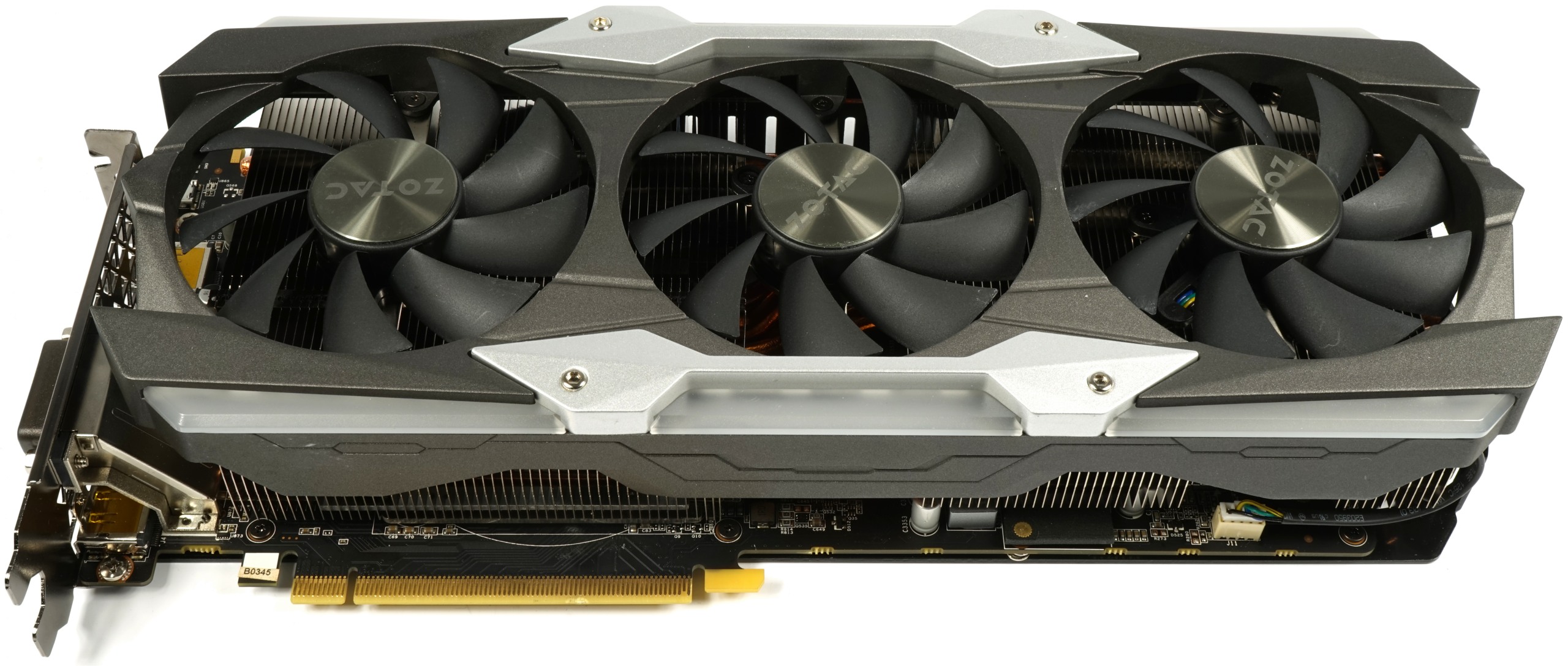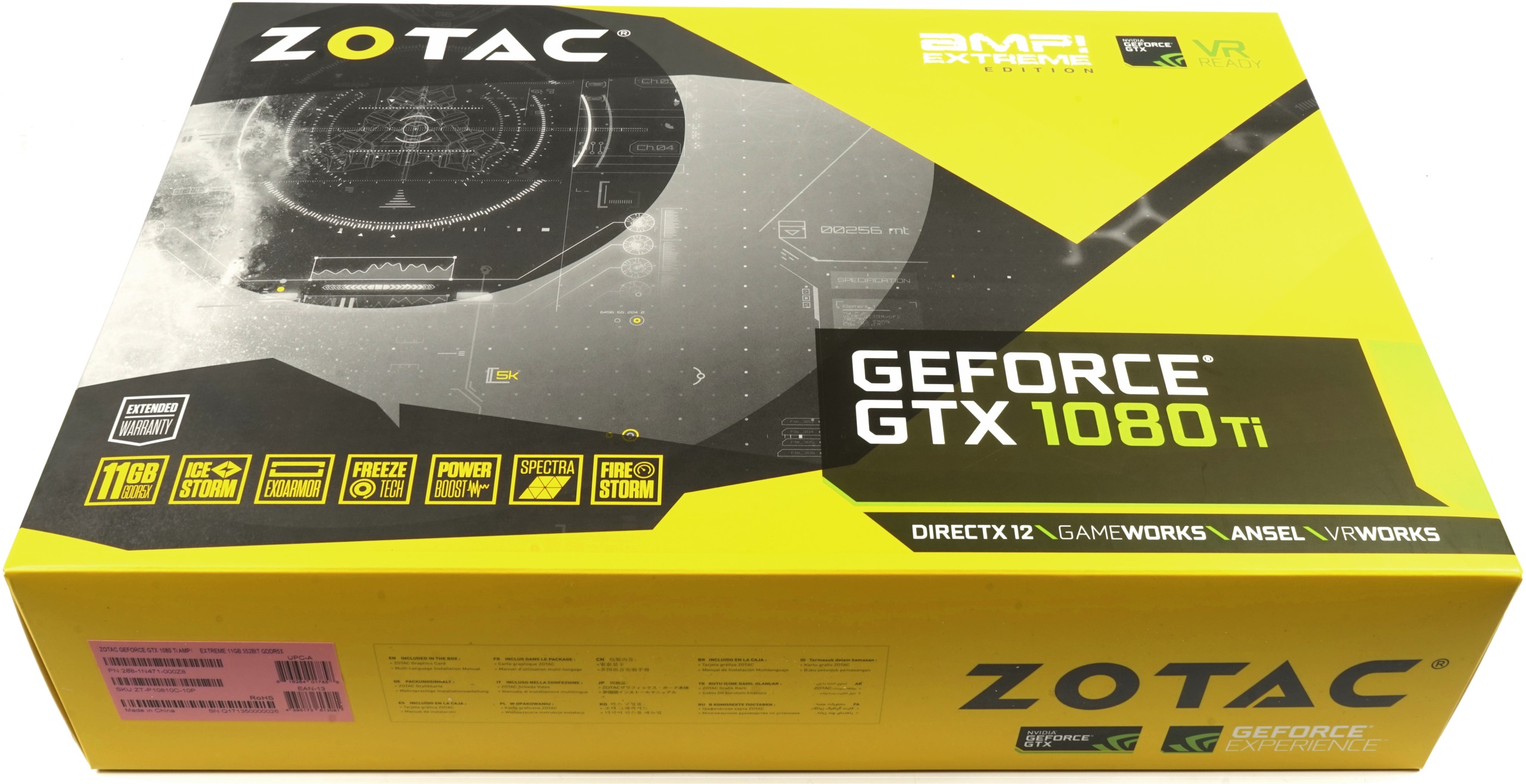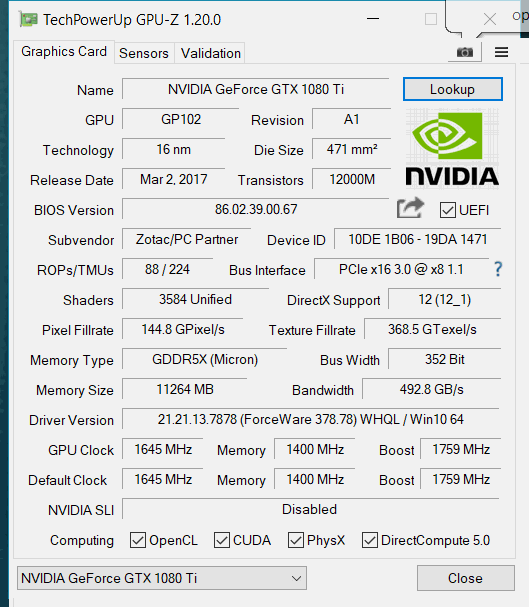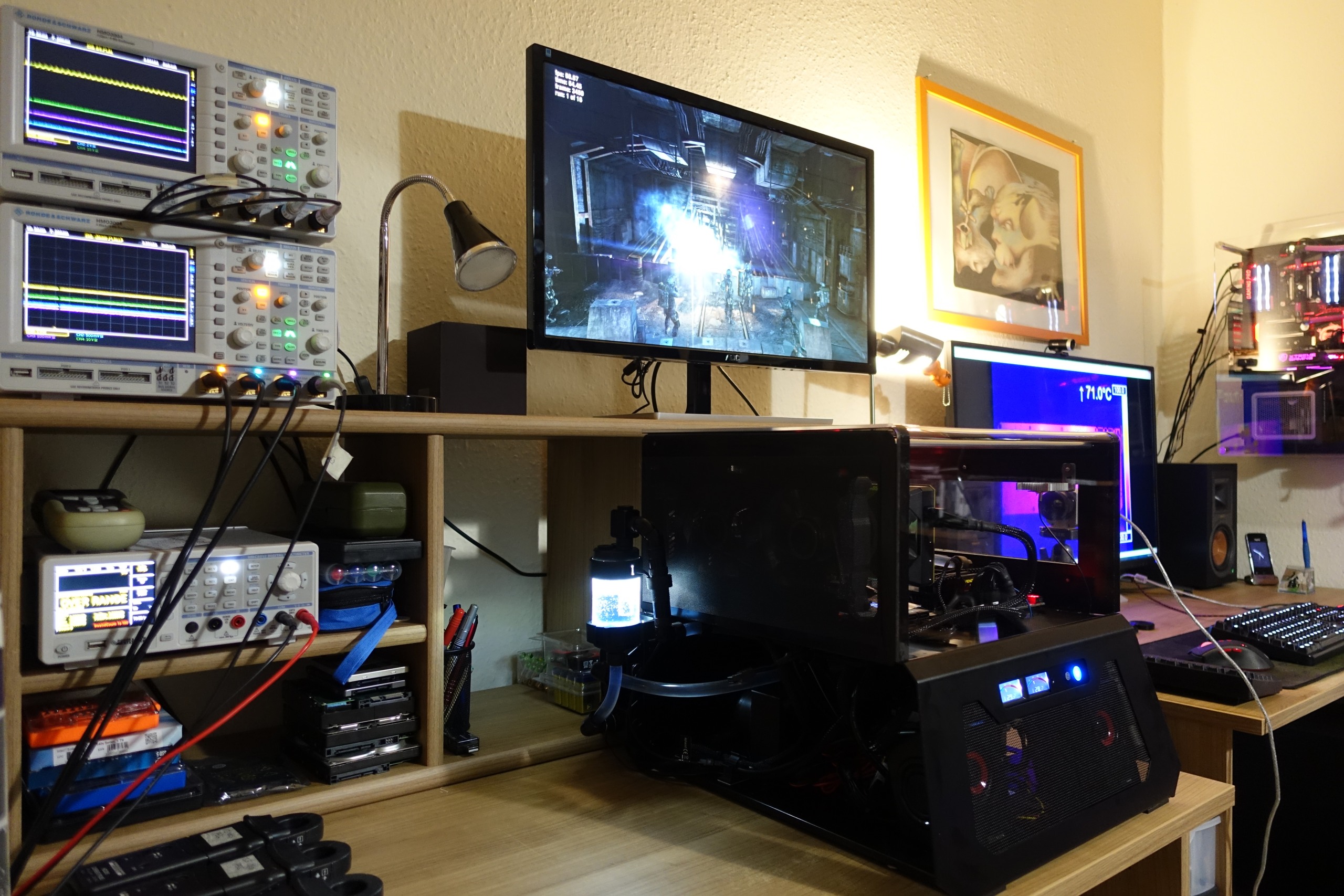Early Verdict
Zotac builds a capable GeForce GTX 1080 Ti card that addresses feedback we passed along about previous products. But it has other weaknesses we want to see fixed, such as insufficient VRM cooling and high fan speeds. Still, the company's heat sink holds lots of untapped potential and an attractive price tag turns heads.
Pros
- +
Factory-overclocked GPU and memory
- +
Massive heat sink and coolers
- +
Excellent build quality
- +
One of the lower-priced 1080 Tis
Cons
- -
Insufficient cooling on VRMs
- -
Louder than competing GeForce GTX 1080 Tis
- -
VRM noise
Why you can trust Tom's Hardware
Features & Specifications
As a PC Partner brand (like Inno3D), Zotac celebrated its 10-year anniversary last winter. The company's success isn't just attributable to its many mainstream-oriented products, but also the enthusiast-class hardware it sells. Hardcore gamers with deep pockets are the ones Zotac wants to attract with its GeForce GTX 1080 Ti AMP Extreme.
Since the actual performance of any third-party card depends on the GPU Boost frequency it can sustain, and thus on cooling, power limits, and processor quality, any review that relies on bar charts is little more than a snapshot of a single specimen. That's why we're putting our emphasis on the actual implementation of each model. To that end, a lot of equipment goes into thoroughly documenting a graphics card's behaviors. If you'd like a peek at what goes into such an evaluation, check out our Nvidia GeForce GTX 1080 Ti 11GB Review. It makes for a good baseline on which Zotac builds.
Specifications
The Package, Dimensions & Interfaces
With an extreme weight of 1.568kg, this card is a whopper, to be sure. It measures 31cm from the slot bracket's outer edge to the shroud's back. A 13cm height is slightly shorter than other GeForce GTX 1080 Tis we've reviewed, and a thickness of 5.3cm is a little slimmer, too. Still, you'll need to reserve three expansion slots to accommodate it. And the GeForce GTX 1080 Ti AMP Extreme requires an extra 0.5cm of clearance on the other side as well; keep that in mind if you're using a large CPU cooler.
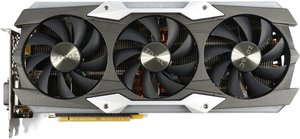
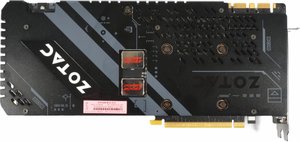
Although Zotac uses mostly plastic for the card's cover, it feels fairly classy.
If you turn the GeForce GTX 1080 Ti AMP Extreme over in your hands, it's apparent that Zotac's backplate wraps around on the top and back, helping stabilize the frame a bit. The plate's primary purpose is to look pretty, though. Unfortunately, it doesn't help with cooling (though we're willing to bet the company changes this at some point).
Up top, you'll find an RGB-backlit Zotac logo and a white, printed GeForce GTX label. A pair of eight-pin power connectors is positioned at the end of the board and rotated by 180°.
Peeking into the top and bottom reveals that the cooler's fins are oriented vertically. We don't see a VRM heat sink, which could have helped with cooling. In its place, the board features a piece of extruded aluminum that receives some airflow from the fans above.
Get Tom's Hardware's best news and in-depth reviews, straight to your inbox.
The card's back side reveals two 8mm and three 6mm heat pipes for the right part of the cooler structure. At this angle and from the outside, Zotac's fourth 6mm pipe is not visible.
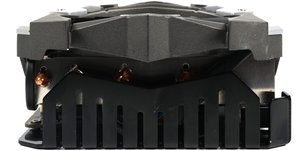
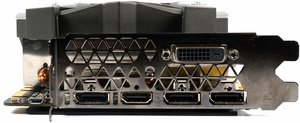
The slot bracket features five display outputs, of which a maximum of four can be used simultaneously in a multi-monitor setup. In addition to one dual-link DVI connector, the bracket also hosts a HDMI 2.0b port and three DisplayPort 1.4-capable interfaces. Remember that Nvidia retired DVI from its Founders Edition design, so Zotac had to bring it back for this board. The rest of the slot plate is dotted with openings for airflow, though they're not functional due to Zotac's fin design.
A GPU-Z screenshot provides the most pertinent technical information, even if the GPU Boost values we observed were much higher than Zotac's official specifications.
| Header Cell - Column 0 | Nvidia Titan X (Pascal) | Nvidia GeForce GTX 1080 Ti FE | Zotac GeForce GTX 1080 Ti AMP Extreme | Nvidia GeForce GTX 1080 FE | Nvidia GeForce GTX 980 Ti |
|---|---|---|---|---|---|
| GPU | GP102 | GP102 | GP102 | GP104 | GM200 |
| CUDA Cores | 3584 | 3584 | 3584 | 2560 | 2816 |
| Base Clock Rate | 1417 MHz | 1480 MHz | 1645 MHz | 1607 MHz | 1000 MHz |
| GPU Boost Clock Rate | 1531 MHz+ | 1582 MHz+ | 1759 MHz | 1733 MHz+ | 1076 MHz+ |
| Memory Size and Type | 12GB GDDR5X | 11GB GDDR5X | 11GB GDDR5X | 8GB GDDR5X | 6GB GDDR5 |
| Die Size | 471 mm² | 471 mm² | 471 mm² | 314 mm² | 601 mm² |
| Process Technology | 16nm | 16nm | 16nm | 16nm | 28nm |
| Transistors | 12 billion | 12 billion | 12 billion | 7.2 billion | 8 billion |
| Streaming Multiprocessors (SM) | 28 | 28 | 28 | 20 | 22 |
| GFLOPS (Base Clock) | 10,157 | 10,609 | 11,791 | 8228 | 5632 |
| Texture Units | 224 | 224 | 224 | 160 | 176 |
| Texture Fill Rate | 317.4 GT/s | 331.5 GT/s | 368.5 GT/s | 257.1 GT/s | 214 GT/s |
| ROPs | 96 | 88 | 88 | 64 | 96 |
| Pixel Fill Rate | 136 GPix/s | 130.24 GPix/s | 144.8 GPix/s | 114.2 GPix/s | 116.7 GPix/s |
| Memory Data Rate | 10 Gb/s | 11 Gb/s | 11 Gb/s | 10 Gb/s | 7 Gb/s |
| Memory Bus | 384-bit | 352-bit | 352-bit | 256-bit | 384-bit |
| Memory Bandwidth | 480 GB/s | 484 GB/s | 492.8 GB/s | 320 GB/s | 336 GB/s |
| L2 Cache | 3MB | 2816KB | 2816KB | 2MB | 3MB |
| TDP | 250W | 250W | 300W (Power Target) | 180W | 250W |
Test System & Measurement Methods
We explained our test system and methodology in How We Test Graphics Cards. If you want to learn more about the procedures we're using in today's review, have a look at that story.
Since its publication, however, we did beef up our platform and CPU cooling, mostly to rule out the possibility of a processor-imposed bottleneck. This is particularly important given the flagship status of Nvidia's GeForce GTX 1080 Ti.
| Test Equipment And Environment | |
|---|---|
| System | Intel Core i7-6900K @ 4.3 GHzMSI X99S XPower Gaming TitaniumCorsair Vengeance DDR4-32001x 1TB Toshiba OCZ RD400 (M.2, System SSD)2x 960GB Toshiba OCZ TR150 (Storage, Images)be quiet Dark Power Pro 11, 850W PSUWindows 10 Pro (All Updates) |
| Cooling | Alphacool Eisblock XPXAlphacool Eiszeit 2000 Chiller2x be quiet! Silent Wings 3 PWM (Closed Case Simulation)Thermal Grizzly Kryonaut (Used when Switching Coolers) |
| PC Case | Lian Li PC-T70 with Extension Kit and ModsConfigurations: Open Benchtable, Closed Case |
| Power Consumption Measurement | Contact-free DC Measurement at PCIe Slot (Using a Riser Card)Contact-free DC Measurement at External Auxiliary Power Supply CableDirect Voltage Measurement at Power Supply2 x Rohde & Schwarz HMO 3054, 500MHz Digital Multi-Channel Oscilloscope with Storage Function 4 x Rohde & Schwarz HZO50 Current Probe (1mA - 30A, 100kHz, DC) 4 x Rohde & Schwarz HZ355 (10:1 Probes, 500MHz) 1 x Rohde & Schwarz HMC 8012 Digital Multimeter with Storage Function |
| Thermal Measurement | 1 x Optris PI640 80Hz Infrared Camera + PI ConnectReal-Time Infrared Monitoring and Recording |
| Noise Measurement | NTI Audio M2211 (with Calibration File, Low Cut at 50Hz)Steinberg UR12 (with Phantom Power for Microphones)Creative X7, Smaart v.7Custom-Made Proprietary Measurement Chamber, 3.5 x 1.8 x 2.2m (L x D x H)Perpendicular to Center of Noise Source(s), Measurement Distance of 50cmNoise Level in dB(A) (Slow), Real-time Frequency Analyzer (RTA) Graphical Frequency Spectrum of Noise |
MORE: Best Graphics Cards
MORE: Desktop GPU Performance Hierarchy Table
MORE: All Graphics Content

Igor Wallossek wrote a wide variety of hardware articles for Tom's Hardware, with a strong focus on technical analysis and in-depth reviews. His contributions have spanned a broad spectrum of PC components, including GPUs, CPUs, workstations, and PC builds. His insightful articles provide readers with detailed knowledge to make informed decisions in the ever-evolving tech landscape
-
dstarr3 Boy, looking at how hard it is to keep these things cool, I'm thinking it'd be better to wait until the next generation and the efficiency improvements that'll bring. May only be a 10-15% bump in performance, but if it means a card that's producing reasonable amounts of heat again with a not-triple-slot cooler, that's worth the wait.Reply -
EpIckFa1LJoN I have this card. It cools great. I have a pretty low airflow case and it never goes over 66C and thats on BF1 in "The Runner" at 3440x1440. Very consistently at 2000MHz or higher on stock settings (fan too). You can easily set a fan curve as long as it doesn't conflict with the idle profile. Zotac set the card to always be at 0% fan speed under something like 39C (not 49C I know that for a fact). The fans are completely unresponsive until it goes into active mode. I also know unless you set the curve to kick in right as it comes out of idle mode the fans will spin up past 100% before settling down to whatever value they are at.Reply
As for the noise... I have 5 ML140's all (were) set less than 900RPM, and I have a Seasonic Prime Titanium 850W PSU, in a Corsair 750D case, also a Corsair H115i cooler also with ML140 fans set about 900rpm, and I could never even hear the GPU until it hit about 58% (which it never does under normal circumstances). I consider my rig extremely quiet even as it sits 3 feet away from my face on my desk I can't hear it even in a dead silent room, where even a whisper would disturb the peace. You must have bat-like hearing to call this card loud.
I have since upped all my fan speeds as I have overclocked my 6700K to its thermal limit so far. H115i pump is set to almost 3000rpms, fans on that are set to around 1350rpms, the case fans are set to 1100rpms, and I always keep my ceiling fan on now to help the air flow in my room. With my gaming headset on the GPU could go up to 75% before I hear it. And the ceiling fan is still louder than the rest of my rig FYI.
I absolutely love this card, it is a brute-force method of cooling and overclocking, but I don't mind at all, it's an absolute beast when it comes to running my Acer Predator X34. There isn't a (at least decently) optimized game I can't play at 100Hz Ultra 3400x1440. -
Nei1 Re: GPU for computing, http://boinc.berkeley.edu/wiki/GPU_computingReply
And the other thing besides gaming is to use the computational power of today's GPUs for processing Distributed Computing Project work-units, as described in the Berkeley link. Do any of Tom's measurements indicate if this GPU would survive if it were driven to 100% load continuously, or what percentage would be catastrophic (given ambient temperature or whatever)? Or shall we project-participants assume that if we set our project-clients to run the GPU at 100%, it wouldn't be a problem? Heat is the enemy; it would help to know what heat sensors are available, what apps are available to monitor the temp(s), so that we may reduce the load as necessary, possibly automatically. One could use some guidance about how to run the GPU, perhaps not at its maximum limit, for longevity and error free computations.
Thanks. -
JDubstep I don't know that the fuss about the noise was. I hear my case fans and water cooling pump before I hear the card. Even still, I wear headphones most of the time I'm at my computer gaming and the only noticeable detail? Card sag. My riser cable came in today and I'll address that accordingly. Other than that, my gripes are: a) the YouTube tech community still failing to review and publicize this beast b) you might have to hit the weights more in order to put this card into your system. Other than that, it's money well spent. I'd even go as far to say better than the KingPin cards coming out soon too.Reply -
FormatC Reply
Feel you free to send me any files to check it. But I measure all things on an offline-system. It is secure. I measure the VGA cards with Furmark over a longer time, not only a few minutes. That gives me a good overview about the quality of the PCBs and the cooling. This Zotac is simply to hot for my taste (VR area).19788805 said:Re: GPU for computing, http://boinc.berkeley.edu/wiki/GPU_computing
And the other thing besides gaming is to use the computational ... Thanks.
-
EpIckFa1LJoN Reply19789269 said:I don't know that the fuss about the noise was. I hear my case fans and water cooling pump before I hear the card. Even still, I wear headphones most of the time I'm at my computer gaming and the only noticeable detail? Card sag. My riser cable came in today and I'll address that accordingly. Other than that, my gripes are: a) the YouTube tech community still failing to review and publicize this beast b) you might have to hit the weights more in order to put this card into your system. Other than that, it's money well spent. I'd even go as far to say better than the KingPin cards coming out soon too.
Exactly! The only problem I have with mine (since I have a GPU Brace) is the fact that there are basically two fan profiles and the fans are 100% unresponsive under 40C. So you have to set a fan profile that kicks on AFTER the stock profile for it to work. It's a workaround at least. TweakTown's review has it beating every other 1080 Ti that has come out so far. -
threecs You can deactivate the "always idle" fan functionality through the Zotac Firestorm software. Install and run Firestorm. Select Spectra. The middle panel will have a small - easy to miss - down arrow. Press it and it will reveal a "Fan stop setting ON/OFF". When set to OFF the fans will always follow any custom settings.Reply -
JDubstep Prior to running stress tests I did the following:Reply
-opened up the card and applied Thermal Grizzly in lieu of MFR thermal paste
-mounted my card to the side of my case with a riser cable and mount
Notables:
-ambient temperature was 23ºC
-ran FurMark at the following settings: 1920x1080 AA-8X MSAA
-GPU runs a three monitor setup; all are 1080p/144Hz/1ms and monitor 1 was used
-GPU clocks were stock with the boost clock at 1974 MHz and memory at 5599 MHz
**edit**
-two tests consisted of approximately 30 mins of stressing with ample cool-down time in between (44ºC)
End results
-min FPS: 67, max FPS: 71, avg FPS: 70
-GPU utilized 85% TDP, 69% fan speed, temperature 70ºC
-no SLM was used; most prevalent noise was due to water pump, case fans, and coolant being flushed back into reservoir
My take:
Not the most 'sound' way to prove a point, but since my parts came in I decided to apply some decent thermal paste while I had the case open and the card out. The board sag was irking me, so I rectified that as well. I do believe in the process that by positioning the card in this manner I have: a) probably reduced the ambient heat in the case and b) increased the level of sound I would hear from the fans as it sits right up against the tempered glass panel. This being said, I honestly have yet to see my card fans push 100%. I don't dabble in overclocking GPUs, and with this beast you really shouldn't have to do that. With an MSRP of $729 (currently on sale), this price point not only trumps a majority of the non-reference cards in price, but all of them in performance as well. I'm quite happy with my purchase, and I really think all this talk of 'coil whine' is either a farce or a fluke. Go buy the card off of Newegg and return it after 20 days if it whines. After that, go buy your FTW3 or Strix. Neither one of these will compare, IMHO. -
rlssetiawan Anyone experience have to underclock the core clock ? I have to underclock it -20 up to -40 just to have stable performance. Fire strike/heaven or gaming will be freezing in default setting. Experienced this on 2 cards of zotac 1080 ti amp extreme.Reply
